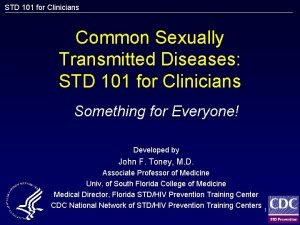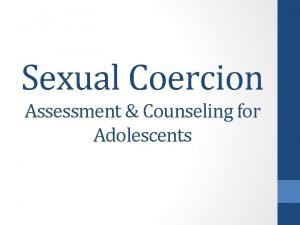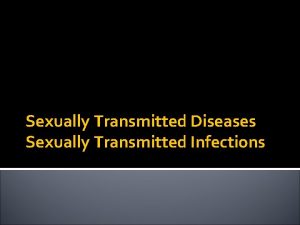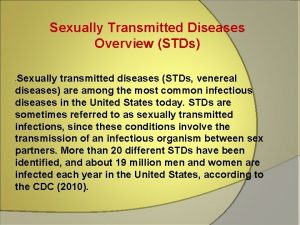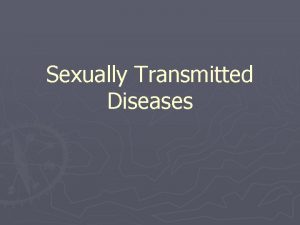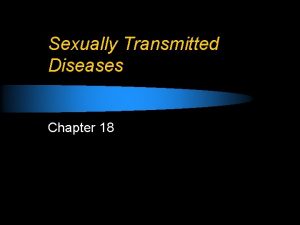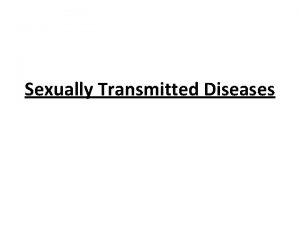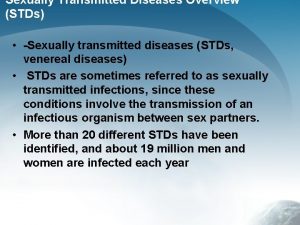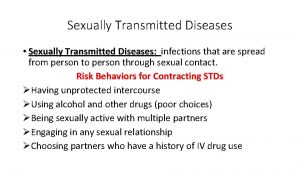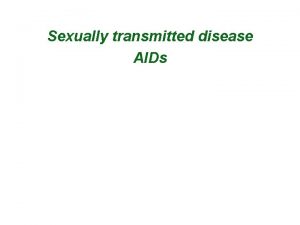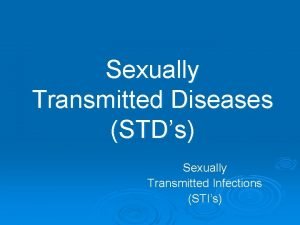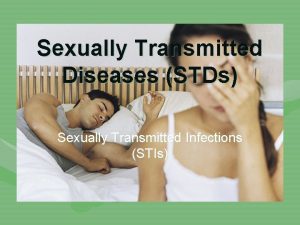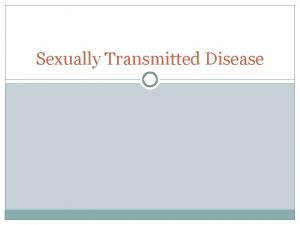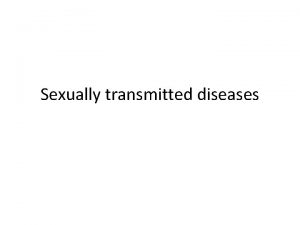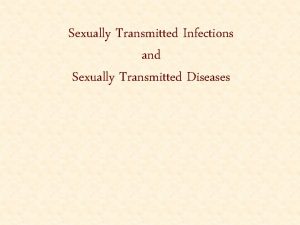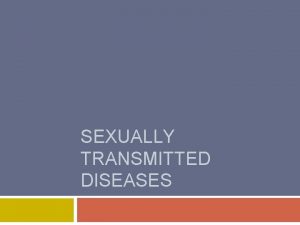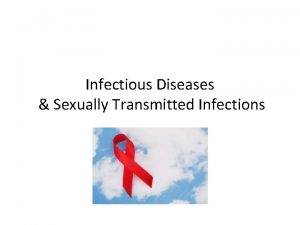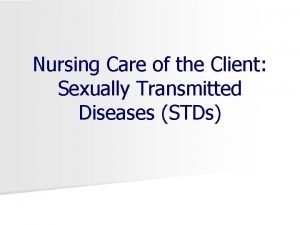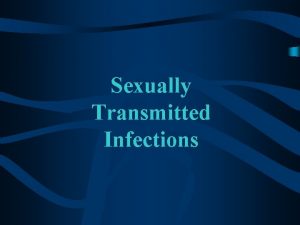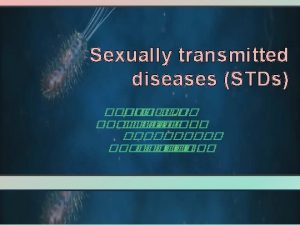Nursing Care of the Client Sexually Transmitted Diseases






































- Slides: 38

Nursing Care of the Client: Sexually Transmitted Diseases NVOC 22 C Eliza Rivera-Mitu, RN, MSN

What are STDs?

Chlamydia n n Known as the silent STD Symptoms: – males - 1 -25% show no symptoms; watery or milky discharge from penis, burning sensation upon urination: – females - 70% show no symptoms; abnormal vaginal discharge &/or bleeding, abnormal cramping, abdominal pain, fever, painful urination. – Oral - sore throat: Rectal - inflammation, itching n Incubation: 1 to 4 weeks

Chlamydia n Organism: Chlamydia trachomatis & Ureplasma urealyticum, bacteria n Infectivity: people can infect other when they have symptoms & some times when they do not, the partner is infected in approximately 33% of the sexual contacts with an infected partner

Chlamydia - Symptoms


Chlamydia n Treatment: can be cured with antibiotics – Doxycycline is tx of choice n If Untreated: – males - inflammation of testicles, infected prostate – females - pelvic inflammatory disease, ectopic pregnancies – both sexes - sterility – fetus/newborns -pneumonia, death, eye & ear infections


Chlamydia n Prevention: limit the number of sexual partner & use condoms & spermicides What are the Nursing Implications?

Gonorrhea n Symptoms: – males - discharge of pus from penis, burning sensation upon urination, blood in urine & around 10% show no symptoms especially with the first infection

Gonorrhea n Females - foul smelling vaginal discharge &/or bleeding, abnormal cramping &/or painful urination n Both sexes – n rectal - itching, pain, discharge with blood or pus; oral sore throat & swollen glands

Gonorrhea Incubation: 2 to 7 days n Organism: Neisseria gonorrhoae, a bacterium n Infectivity: people can infect others when they have symptoms & some times when they do not; women are more easily infected by men than vice versa; the partner is infected in approximately 25% of the sexual contacts with an infected partner n

Gonorrhea n Treatment: antibiotics can be cured with – Most effective: Single dose of Cipro, followed by a 7 -day course of oral Doxycycline (Vibramycin) n If Untreated: – males - blockage of urethra, problems with erection;

Gonorrhea – females - pelvic inflammatory disease, ectopic pregnancies, fetus/newborns premature birth, still birth & eye infection; – both sexes - sterility, arthritis, heart problems, blindness

Gonorrhea n Prevention: limit number of sexual partners & use condoms & spermicides What are the nursing implications?

Syphilis n Symptoms: – both sexes § primary stage: small painless sore (chancre) where organism entered body, genital, oral or rectal ( in women can't be seen internally) § secondary stage: rash on palms & soles, open painless sores often in mouth § late stage: neurological damage, blindness, death

Syphilis

Syphilis n Incubation: – primary stage - 10 to 70 days, 21 days in most people; – secondary stage - weeks to a year; – late stage – years n Organism: Treponema pallidum, a bacterium

Syphilis Infectivity: people can infect others when they have symptoms & possibly when they do not, the partner is infected in approximately 50% of the sexual contacts with an infected person n Treatment: can be cured with penicillin & other antibiotics n

Syphilis n If Untreated: – males - inflammation of testicles, infected prostate; – females - pelvic inflammatory disease; ectopic pregnancies; both sexes - sterility; – fetus/newborns - blindness, deafness, early death due to syphilis n Prevention: limit number of sexual partners & use of condoms & spermicides may reduce transmission Nursing Implications?

Genital Herpes n Symptoms: rash & itching; painful, fluid filled blisters, fever, fatigue (similar in both sexes), & vaginal discharge(females only); symptoms go away but reappear since the virus stays in the body n Incubation: 4 to 10 days

Genital Herpes n Organism: Herpes simplex II (90% of cases) & Herpes simplex I, viruses n Infectivity: people can infect others when they have symptoms & some times when they do not

Genital Herpes Treatment: use Betadine on lesions to dry & prevent secondary infections, however, Acyclovir (Zovirax) eases symptoms & lessens reoccurrence but is not a cure n If Untreated: in fetus/newborns there is a risk of spontaneous abortion; neonatal herpes; mental retardation, death n Prevention: limit number of sexual partners and using condoms & spermicidal foam may reduce transmission Nursing Implications? n

CMV - Cytomegalovirus n Found is saliva, urine, semen, and vaginal secretions n symptoms include pharyngitis, malaise, fever and lymphadenopathy, heterophil antibody negative, blood smears may show atypical lymphocytes n may be fatal to those patients with AIDS

CMV n Treatment: most resolve spontaneoulsy n therapy is often required for immunosuppressed patients n Ganciclovir

Genital Warts Symptoms: warts on genitals, rectum or throat (not always easy to see) & (similar in both sexes) n Incubation: 1 to 20 months; usually about 4 months n

Genital Warts Organism: Human Papilloma Virus HPV n Infectivity: people can infect others when they have lesions & sometimes when they do not; 66% of people who have sexual contact with a partner who has genital warts will develop genital warts, usually within 3 months n Treatment: chemical treatments such as podophyllum in tincture of benzoin, electrocoagulation ("burning"), cryotherapy ("freezing"), laser surgery, & excision are all used with variable success n

Genital Warts Untreated: both sexes - warts grow & obstruct infected body openings, precancerous lesions of the cervix, vulva, & penis have been linked to some types of HPV. n Prevention: limit number of sexual partners & use of condoms & spermicides may reduce transmission n If

HIV (Human Immunodeficiency Virus) AIDS (Acquired Immunity Deficiency Syndrome) HIV is NOT the same as having AIDS, it is only the virus that causes AIDS. n Currently there is NO cure but drug therapies "show great promise in managing HIV infection". n "HIV infected people are healthy and do not realize they have been infected. HIV primarily infects certain white blood cells that manage the operation of the immune system. n

HIV (Human Immunodeficiency Virus) AIDS (Acquired Immunity Deficiency Syndrome) Eventually, the virus can disable the immune system, leaving the person with HIV infection vulnerable to a number of life-threatening illnesses. n People who have HIV infection may not have symptoms for many years, especially if they receive good medical care and effective therapies" (American College Health Association [ACHA] , 2001). n

HIV (Human Immunodeficiency Virus) AIDS (Acquired Immunity Deficiency Syndrome) n "When symptoms do develop, they are usually similar at first to those of common minor illnesses, such as the "flu", except that they last longer and are more severe. n Persistent tiredness, unexplained fevers, recurring night sweats, prolonged enlargement of the lymph nodes, and weight loss are all common.

HIV (Human Immunodeficiency Virus) AIDS (Acquired Immunity Deficiency Syndrome) People with HIV infection can transmit the virus to others - even if they have no symptoms and even if they do not know they have been infected. n HIV can be transmitted (1) by sexual contact (anal, vaginal, & oral); (2) by direct exposure to infected blood; and (3) from an HIVinfected woman to her fetus during pregnancy or childbirth, or to her infant during breastfeeding" (ACHA, 2001). n

HIV (Human Immunodeficiency Virus) AIDS (Acquired Immunity Deficiency Syndrome) n Prevention: – "make careful choices about sexual activity, – communicate assertively with your sexual partner and negotiate for safer sexual practices, – remove alcohol and drugs from sexual activity, " and – "use latex condoms for intercourse" (ACHA, 2001).

Trichomoniasis n Symptoms: – Most men with trichomoniasis do not have signs or symptoms; – some men may temporarily have an irritation inside the penis, mild discharge, or slight burning after urination or ejaculation.

Trichomoniasis n Symptoms – frothy, yellow-green vaginal discharge with a strong odor – discomfort during intercourse and urination, – irritation and itching of the female genital area. – lower abdominal pain n Incubation: 4 to 10 days

Trichomoniasis n Organism: Trichomoniasis is caused by the singlecelled protozoan parasite, Trichomonas vaginalis.

Trichomoniasis n Infectivity: The vagina is the most common site of infection in women, and the urethra (urine canal) is the most common site of infection in men. – The parasite is sexually transmitted through penis-to-vagina intercourse or vulva-to-vulva (the genital area outside the vagina) contact with an infected partner. – Women can acquire the disease from infected men or women, but men usually contract it only from infected women.

Trichomoniasis Treatment: Trichomoniasis can usually be cured with the prescription drug, metronidazole, given by mouth in a single dose. n If Untreated: increases a woman's susceptibility to HIV infection if she is exposed to the virus. n – Pregnant women with trichomoniasis may have babies who are born early or with low birth weight (less than five pounds). n Prevention: limit number of sexual partners and using condoms & spermicidal foam may reduce transmission Nursing Implications?
 Chapter 24 lesson 1 sexually transmitted diseases
Chapter 24 lesson 1 sexually transmitted diseases Chapter 24 sexually transmitted diseases and hiv/aids
Chapter 24 sexually transmitted diseases and hiv/aids Sexually transmitted diseases
Sexually transmitted diseases Sexually transmitted diseases
Sexually transmitted diseases Chapter 25 sexually transmitted infections and hiv/aids
Chapter 25 sexually transmitted infections and hiv/aids Sexually transmitted disease
Sexually transmitted disease Ocd nursing care plan
Ocd nursing care plan Post operative nursing care
Post operative nursing care Zero client vs thin client
Zero client vs thin client Client lourd vs client léger
Client lourd vs client léger Thin client vs thick client
Thin client vs thick client Primary care secondary care tertiary care
Primary care secondary care tertiary care How do whales reproduce sexually
How do whales reproduce sexually Segmentation nematoda
Segmentation nematoda Invertebrates characteristics
Invertebrates characteristics Run away selection
Run away selection What is sexual coercion
What is sexual coercion How protists reproduce
How protists reproduce Was it sexual abuse quiz
Was it sexual abuse quiz Urchin
Urchin Do protists reproduce sexually
Do protists reproduce sexually Arousal hormones
Arousal hormones Annelids
Annelids Have i been sexually harassed quiz
Have i been sexually harassed quiz Atis sexually or asexually
Atis sexually or asexually Cnidaria class
Cnidaria class Do jellyfish reproduce sexually
Do jellyfish reproduce sexually Unpathetic freightment
Unpathetic freightment Spongia officinalis
Spongia officinalis How birds mate
How birds mate Sexually dimorphic meaning
Sexually dimorphic meaning Illinois sex offender management board
Illinois sex offender management board Transmitted light examination in questioned document
Transmitted light examination in questioned document A song transmitted orally which tells a story:
A song transmitted orally which tells a story: Brakes mcq
Brakes mcq Electronically transmitted postal ballot system
Electronically transmitted postal ballot system The totality of learned socially transmitted behavior
The totality of learned socially transmitted behavior Hát kết hợp bộ gõ cơ thể
Hát kết hợp bộ gõ cơ thể





